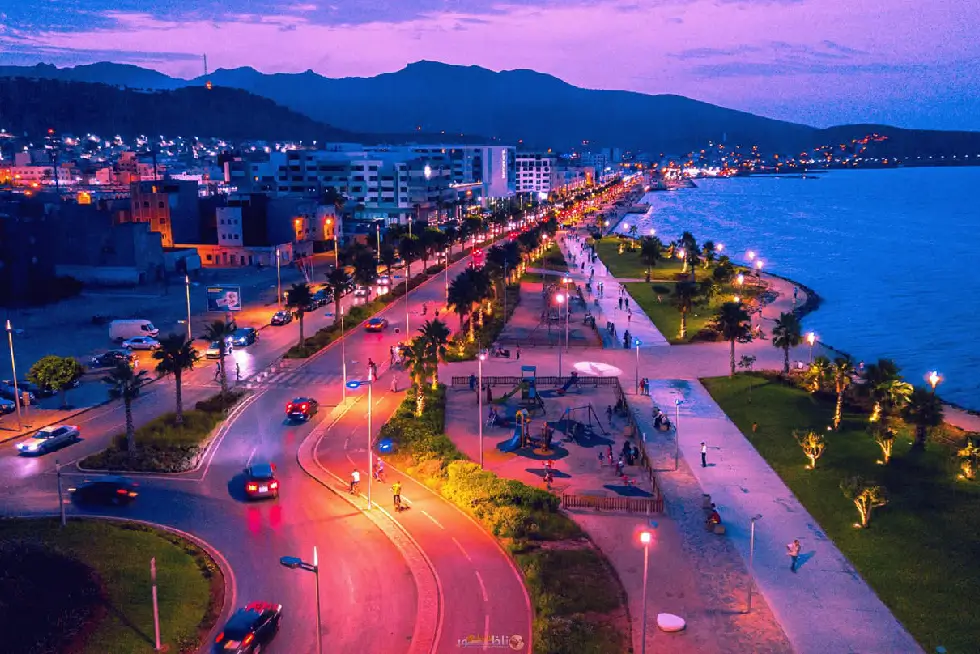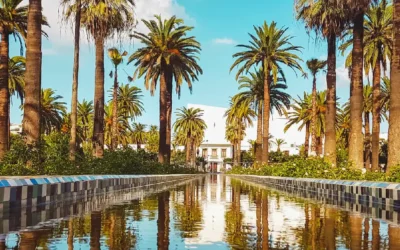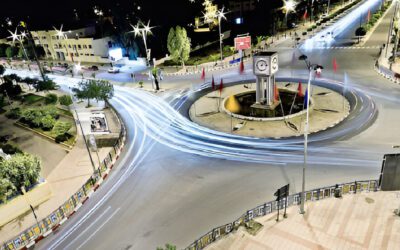Nador City: The Gateway to the Rif of Morocco

Table of Contents:
Introduction to Nador City
Nador, a vibrant coastal city in northeastern Morocco, which is the Oriental region, is a natural beauty. It is the 19th largest city in Morocco and the capital of the Nador Province. Notably, Nador is situated on the Sebkha Bou Areq lagoon along the Mediterranean.
This city is more than just a scenic spot; it’s a vital trading hub, especially known for its fish, fruits, and livestock dealings.
With a population exceeding 200,000, Nador is alive with diverse cultures and histories. Its stunning beaches, mountain ranges, and lush forests amplify the city’s charm, making it a visually captivating destination.
Geographically unique, Nador is intriguingly positioned near a salt lagoon, just 10 km south of Melilla and 75 km from the Algerian border, marking it as an important regional crossroads.
Nador Discovery Tour
Explore and Discover the vibrant city of Nador, with its captivating tourist attractions. Let’s delve into this guide to the city’s must-visit spots:
1. Monte Gurugu
A haven for nature lovers, this area boasts breathtaking mountain views and abundant wildlife, perfect for outdoor adventures.
2. Laguna de la Marchica
Discover peace and natural splendor at this picturesque lagoon.
3. Mar Chica Beach
Relax on this scenic beach, one of 29 in the region, renowned for its serene atmosphere.
4. Charrana and Bocana Beaches
Each beach in Nador offers a unique coastal charm, and these are no exception.
5. Corniche de Nador
Stroll along this popular pier and boardwalk, enjoying stunning views of Laguna Marchica.
6. Souk Oulad Mimoun
Immerse yourself in local culture and shopping at this bustling market.
7. I Love Nador
While details are scarce, this spot is touted as a favorite among visitors.
8. Mosque Mohamed V
A cultural and religious icon of the city, this mosque is a must-see.
9. Parc Ornithologique
Ideal for bird enthusiasts and nature lovers.
10. Port De Pêche Et De Plaisance & Pont D’amour
Notable landmarks offering insights into Nador’s heritage.
11. La Cite des Deux Mers
Another key site enriching Nador’s landscape.
12. Rif Mountains
For the adventurous, these mountains provide stunning vistas and hiking trails.
13. Nador Beach
Part of the city’s charming coastline.
14. Ait Baha Forest
A serene forest setting for nature explorers.
Nador Accessibility And Transportation
Nador provides a comprehensive network of transportation options catering to both local and international travelers. Here’s a look at the various modes of transportation available in and around Nador:
A. Ferry Services in Nador
1. Vital Hub
Nador’s port stands as a critical link between Morocco and Europe, offering regular ferries to France and Spain. This connection opens doors to diverse travel experiences.
2. Traveler Amenities
The port area is equipped with essential facilities like cafes, ATMs, and car rental services, ensuring a smooth start or end to your journey.
B. Air Travel to and from Nador
1. Nador International Airport
Positioned 24km from the city, it connects Nador with major European cities. Though public transport is absent, taxis provide easy access to the city.
2. Melilla Airport Alternative
For travelers from Spain, this nearby airport offers a practical option, with taxi services available for border crossing.
C. Train and Bus Connectivity
1. Train Links
The city is well-connected to other Moroccan urban centers through the Taourirt – Nador train line, facilitating seamless travel within the country.
2. Extensive Bus Network
Buses operated by CTM link Nador to various Moroccan cities, providing an expansive network for travelers.
D. Navigating Within Nador
1. Petits Taxis
Perfect for short city trips, these small taxis cater to up to 3 passengers. Fare negotiation is common and recommended.
2. Grands Taxis
For longer distances outside the city, these larger taxis, accommodating up to 7 people, offer both shared and private travel options.
3. Public Buses
Managed by Vectalia, the local bus system is an integral part of Nador’s transport, though it may require some local guidance for efficient use.
Modern Nador and its Economic Significance
1. Nador’s Remarkable Growth
Nador is witnessing a remarkable economic surge. The city’s port, a bustling hub, is pivotal in boosting regional trade with Europe and beyond. This development marks Nador as a crucial player in trade and commerce.
2. Strategic Economic Development
A new economic activity zone is transforming Nador. Positioned to propel investment and social growth, this initiative is set to generate jobs and invigorate the local economy. Nador’s strategic expansion is a testament to its rising economic influence.
3. Diverse Economic Landscape
Nador’s economy is a vibrant mix of fisheries, agriculture, and varied industries. Each summer, over 250,000 visitors from Europe, who originally hail from Nador, return, adding a dynamic layer to its economic fabric.
4. Infrastructure and Tourism Growth
With the Nador Aroui International Airport now leading regional air traffic, and the anticipated Mar Chica resort poised to be Morocco’s largest, Nador is cementing its status as a key economic zone. These developments underscore the city’s infrastructural and tourism advancements.
5. Ongoing Urban Renewal
Undergoing extensive renovations, Nador is steadily evolving. Its port, a major European gateway, along with the newly developed corniche, is enhancing both the economic landscape and quality of life. This ongoing urban renewal is shaping Nador into a prominent economic hub.
Nador History Overview
A. Nador’s Foundation
Founded by local Berber tribes in the 19th century, Nador’s strategic position on the Mediterranean Sea has been central to its story. This prime location not only boosted trade but also positioned Nador as a crucial link between the Mediterranean and Morocco’s interior.
B. From Ancient Empires to Modern Times
Nador’s roots stretch back to prehistoric times, with evidence of Paleolithic-era habitation. It flourished under the Carthaginian and Roman empires, later embracing Islam in the 7th century.
The Islamic era marked Nador as a center for trade and learning. Influential Moroccan dynasties like the Almoravids and Almohads left their mark with impressive architectural legacies.
C. Colonial Imprint and Independence
In 1912, Nador entered a new chapter under Spanish occupation, which lasted until Morocco’s independence in 1956. This period left a lasting impact on Nador’s architecture and cultural fabric.
D. A Melting Pot of Cultures and Traditions
Today, Nador is a vibrant mix of Arabs, Berbers, and Andalusians, reflecting its rich history of civilizations and migrations.
This diversity, along with significant infrastructure projects like the Nador West Med Port, underlines Nador’s ongoing evolution and economic growth.
Conclusion
Nador stands out as a key city in Morocco, blending its rich historical heritage with modern economic development. It’s not just a beautiful coastal destination but also a vital hub for regional trade and cultural exchange, embodying the diverse and dynamic spirit of Morocco. This makes it an exceptional place for travelers to explore and experience.
FAQ
What is Nador?
Nador is a vibrant coastal city in northeastern Morocco, known for its natural beauty, cultural diversity, and significant role as a regional trading hub.
How can one travel to and within Nador?
Nador is accessible via ferry services, Nador International Airport, train, and bus networks. Within the city, petits taxis, grands taxis, and public buses are available.
Is there an airport near Nador?
Yes, Nador Aroui International Airport, located 24 km from the city, connects Nador with major European cities.
Where is Nador located?
Nador is situated in the Oriental region of Morocco, on the Sebkha Bou Areq lagoon along the Mediterranean, near the Algerian border.
What makes Nador a unique destination?
Nador’s stunning beaches, mountain ranges, lush forests, and proximity to a salt lagoon make it a visually captivating and geographically unique destination.
What are the top tourist attractions in Nador?
Key attractions include Monte Gurugu, Laguna de la Marchica, Mar Chica Beach, Souk Oulad Mimoun, Mosque Mohamed V, Parc Ornithologique, and the Rif Mountains.
Are there any notable landmarks in Nador?
Yes, landmarks like Port De Pêche Et De Plaisance, Pont D’amour, and La Cite des Deux Mers enrich Nador’s landscape.
What is the economic significance of Nador?
Nador is experiencing economic growth with its port being a vital trade hub, and developments like the new economic activity zone, diverse industries, and tourism growth emphasizing its economic significance.
What is the historical background of Nador?
Nador was founded by Berber tribes in the 19th century and has a rich history that includes influences from the Carthaginian, Roman, and Islamic eras, and a period of Spanish occupation until Morocco’s independence in 1956.
What is the cultural makeup of Nador?
Nador is a melting pot of Arabs, Berbers, and Andalusians, reflecting its history of civilizations and migrations, and contributing to its vibrant cultural landscape.



